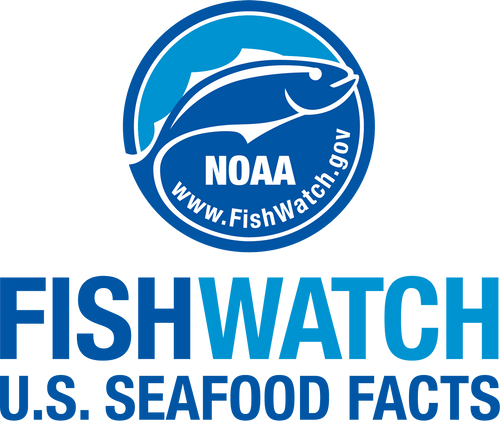 Pacific ocean perch. Credit: NOAA Fisheries
Pacific ocean perch. Credit: NOAA Fisheries
Pacific ocean perch. Credit: NOAA Fisheries
About the Species
 Pacific ocean perch. Credit: NOAA Fisheries
Pacific ocean perch. Credit: NOAA Fisheries
Pacific ocean perch. Credit: NOAA Fisheries
U.S. wild-caught Pacific ocean perch is a smart seafood choice because it is sustainably managed and responsibly harvested under U.S. regulations. A rebuilding plan restricts harvest of overfished Pacific ocean perch on the West Coast.

Population
The stocks are not overfished.

Fishing Rate
Not subject to overfishing.

Habitat Impact
Area closures and gear restrictions protect sensitive rocky, cold-water coral and sponge habitats from bottom trawl gear.

Bycatch
Regulations are in place to minimize bycatch.
Population Status
- There are four stocks of Pacific ocean perch: Gulf of Alaska, Bering Sea/Aleutian Islands, Pacific coast, and one stock contained in a stock complex along the southern Pacific coast. According to the most recent stock assessments:
- The Gulf of Alaska stock is not overfished (2023 stock assessment) and not subject to overfishing based on 2023 catch data. Summary stock assessment information can be found on Stock SMART.
- The Bering Sea/Aleutian Islands stock is not overfished (2022 stock assessment) and not subject to overfishing based on 2023 catch data. Summary stock assessment information can be found on Stock SMART.
- The Pacific coast stock of is not overfished (2017 stock assessment) and not subject to overfishing based on 2022 catch data. Summary stock assessment information can be found on Stock SMART.
- The population status of the Minor Slope Rockfish South Complex, which includes Pacific ocean perch, is unknown. The complex has not been assessed, but according to 2022 catch data, the complex is not subject to overfishing.
Appearance
- Pacific ocean perch are light red with several diffuse, olive-green patches on their upper backs where the body begins to narrow towards the tail fin. They also possess a prominent, cone-shaped knob on their lower jaw.
Biology
- Pacific ocean perch grow slowly and may live to be 98 years old.
- They grow to about 20 inches long and weigh about 4 pounds.
- They do not reproduce until they are around 10 years old.
- Depending on their size, females can produce between 10,000 and 300,000 eggs.
- Pacific ocean perch mate in the fall. Eggs develop inside the female and receive some nourishment from the mother.
- Eggs hatch internally, and females release the larvae in the spring.
- Larvae eat small zooplankton (tiny floating organisms).
- Juveniles and adults feed on copepods and krill, and adults will also eat small fish.
- Pacific ocean perch move off ocean bottom habitats during the day, following daily migrations of krill.
- Seabirds, other rockfish, salmon, lingcod, and other large bottom-dwelling fish feed on juveniles. Sablefish, halibut, and sperm whales feed on adult Pacific ocean perch.
Where They Live
Range
- Pacific ocean perch are found off the coast of North America from California to the Western Aleutian Islands in Alaska.
- They are less commonly found south of Oregon and are particularly rare in Southern California.
Habitat
- Pacific ocean perch live in deeper waters of the upper continental slope and along the edge of the continental shelf.
- Larvae and young juveniles live near the surface, while older juveniles and adults live near the ocean floor.
- Adults prefer sandy and rocky ocean bottoms, areas with vertical relief, and ocean habitats with structure-forming invertebrates, like coral.
- Adults migrate to shallow waters in the summer and offshore in the fall and winter to spawn and live.
Fishery Management
- NOAA Fisheries and the North Pacific Fishery Management Council manage the Pacific ocean perch fishery in Alaska.
- Managed under the Gulf of Alaska and Bering Sea/Aleutian Islands Groundfish Fishery Management Plans:
- Permits are required and the number of available permits is limited to control the amount of fishing.
- Managers determine how much Pacific ocean perch can be caught and then allocate this catch quota among groups of fishermen.
- Catch is monitored through record keeping, reporting requirements, and observer monitoring.
- A percentage of the Aleutian Islands catch is allocated to the Community Development Quota Program, which benefits fishery-dependent communities in western Alaska. The rest is allocated among the BSAI trawl sectors, based on historic harvest and future harvest needs, to improve retention and utilization of fishery resources by the trawl fleet.
- The Central Gulf of Alaska Rockfish Program allows harvesters to fish together in cooperatives. These cooperatives are allocated specific amounts of the allowed catches of rockfish and species harvested incidentally to rockfish. The goal of the program is to spread out the fishery in time and space, allowing fishermen more flexibility to sell their catch for better prices and reducing the pressure of what was once an approximately 2-week fishery in July.
- NOAA Fisheries and the Pacific Fishery Management Council manage the Pacific ocean perch fishery on the West Coast and as part of the Minor Slope Rockfish South Complex.
- Managed under the Pacific Coast Groundfish Fishery Management Plan:
- NOAA Fisheries declared the Pacific coast stock of Pacific ocean perch overfished in 1999. The council adopted a rebuilding plan for the stock in 2000, which prohibited a directed fishery for the species. The stock was declared rebuilt in 2017.
- The regulations listed below that apply to all Pacific groundfish fisheries also provide for the conservation and management of Pacific ocean perch:
- Limit on how much may be harvested in one fishing trip.
- Certain seasons and areas are closed to fishing.
- Gear restrictions help reduce bycatch and impacts on habitat.
- A trawl rationalization catch share program that includes:
- Catch limits that are based on the population status of each fish stock and divided into shares that are allocated to individual fishermen or groups.
- Provisions that allow fishermen to decide how and when to catch their share.
Harvest
- In 2023, commercial landings of Pacific ocean perch totaled 140 million pounds and were valued at $23 million, according to the NOAA Fisheries commercial fishing landings database.
- Gear types, habitat impacts, and bycatch:
- Bottom trawls are primarily used to catch Pacific ocean perch, although pelagic trawls are also used.
- Bottom trawls can contact the ocean floor and impact habitats, depending on the type and sensitivity of the habitat and the size of the gear.
- Trawls cause minimal damage when targeting species over soft, sandy, or muddy ocean bottoms.
- For Alaska and the West Coast, NOAA Fisheries and the regional fishery management councils have implemented large closed areas to protect sensitive rocky, cold-water coral and sponge habitats from bottom trawls.
- In Alaska, trawl fishermen targeting Pacific ocean perch might incidentally catch Pacific cod, arrowtooth flounder, rockfish, and sablefish. Halibut, salmon, and crab may also be caught as bycatch.
- Pacific cod and sablefish are generally retained due to their high commercial value.
- Bycatch limits prevent too much bycatch of other species from being caught. If a target groundfish fishery exceeds a bycatch limit, the fishery may close for the remainder of the season.
Scientific Classification
| Kingdom | Animalia |
|---|---|
| Phylum | Chordata |
| Class | Actinopterygii |
| Order | Scorpaeniformes |
| Family | Scorpaenidae |
| Genus | Sebastes |
| Species | alutus |
Last updated by NOAA Fisheries on 01/27/2025
Featured News
 NOAA Fisheries scientists assess body condition of rockfish using two different fish condition analyzers during an Alaska Fisheries Science Center bottom trawl survey. Credit: NOAA Fisheries.
NOAA Fisheries scientists assess body condition of rockfish using two different fish condition analyzers during an Alaska Fisheries Science Center bottom trawl survey. Credit: NOAA Fisheries.

Seafood Facts

Is Pacific Ocean Perch Sustainable?
U.S. wild-caught Pacific ocean perch is a smart seafood choice because it is sustainably managed and responsibly harvested under U.S. regulations.
Availability
Year-round.
Source
U.S. wild-caught from Alaska to California.
Taste
Delicate, nutty flavor.
Texture
Lean, fairly firm, with a fine flake.
Color
Whole fish should have shiny and bright skin. The raw flesh is white, but turns opaque white when cooked.
Health Benefits
Low in saturated fat and very high in selenium, phosphorous, and vitamin B12.
Nutrition Facts
Servings: 1; Serving Weight: 100 g (raw); Calories: 94; Protein: 18.62 g; Total Fat: 1.63 g; Total Saturated Fatty Acids: 0.244 g; Carbohydrate: 0 g; Total Sugars: 0 g; Total Dietary Fiber: 0 g; Cholesterol: 42 mg; Selenium: 43.3 mcg; Sodium: 75 mgMore Information
Last updated by NOAA Fisheries on 01/27/2025
Seafood News
 Chef Tyler Hadfield’s Curried Skate Wings with Tomato-Masala Chutney
Chef Tyler Hadfield’s Curried Skate Wings with Tomato-Masala Chutney
Ring In the New Year With These Crowd-Favorite Seafood Recipes
 NOAA Fisheries, in collaboration with Blue Ocean Mariculture, is conducting a multi-year pilot study to evaluate observational methods and tools for studying Hawaiian monk seal behavior. Courtesy of Blue Ocean Mariculture
NOAA Fisheries, in collaboration with Blue Ocean Mariculture, is conducting a multi-year pilot study to evaluate observational methods and tools for studying Hawaiian monk seal behavior. Courtesy of Blue Ocean Mariculture
AI Meets Aquaculture to Study Hawaiian Monk Seal Interactions With Net Pens
 Tonya Wick aboard a fishing vessel at sea in 1998. Photo courtesy of Tonya Wick
Tonya Wick aboard a fishing vessel at sea in 1998. Photo courtesy of Tonya Wick
 Fish on display at the market. Credit: Shutterstock
Fish on display at the market. Credit: Shutterstock
Documents
2018 Status of Alaska Marine Ecosystems Considerations - Eastern Bering Sea Report in Brief
The eastern Bering Sea was characterized by anomalously warm conditions in 2018. Over the northern…
Amendment 80 Checklist
Small Entity Compliance Guide for the Amendment 80 Groundfish Trawl Fisheries.
Bering Sea/Aleutian Islands and Gulf of Alaska Harvest Specifications for 2006-2007: Environmental Assessment and Final Regulatory Flexibility Analysis
Environmental Assessment and Final Regulatory Flexibility Analysis of the Gulf of Alaska and Bering…
Data & Maps
2024 Gulf Of Alaska Ecosystem Status Report: In Brief
This assessment summarizes and synthesizes climate, biological, and fishing effects on the shelf…
Ecosystem Status Report 2024 Gulf of Alaska
This assessment summarizes and synthesizes climate, biological, and fishing effects on the shelf…
2024 Aleutian Islands Ecosystem Status Report: In Brief
This assessment summarizes and synthesizes historical climate and fishing effects on the shelf and…
Ecosystem Status Report 2024 Aleutian Islands
This assessment summarizes and synthesizes historical climate and fishing effects on the shelf and…
Research
2023 North Pacific Groundfish Stock Assessments
2023 North Pacific Groundfish Stock Assessment and Fishery Evaluation Reports for 2024 Fisheries
2022 North Pacific Groundfish Stock Assessments
2022 North Pacific Groundfish Stock Assessment and Fishery Evaluation Reports for 2023 Fisheries
North Pacific Groundfish Stock Assessments and Fishery Evaluation Reports
Alaska Groundfish Stock Assessments, Economic Status Reports, and Ecosystem Status Reports.
2021 North Pacific Groundfish Stock Assessments
2021 North Pacific Groundfish Stock Assessment and Fishery Evaluation Reports for 2022 Fisheries
Last updated by NOAA Fisheries on 01/27/2025





